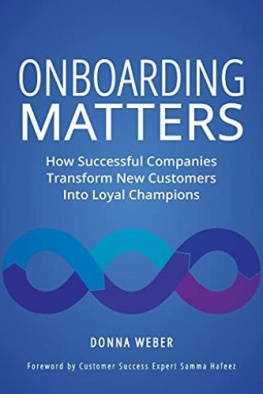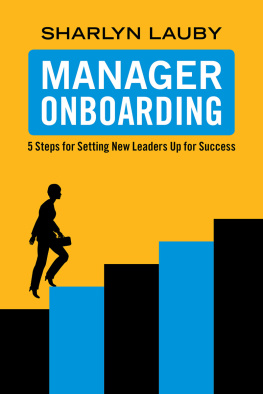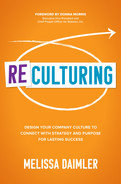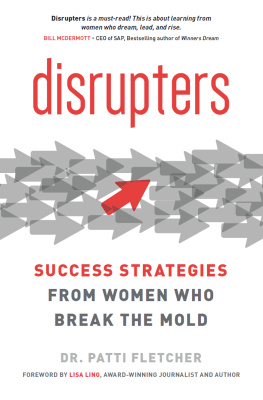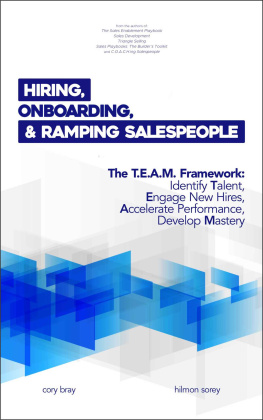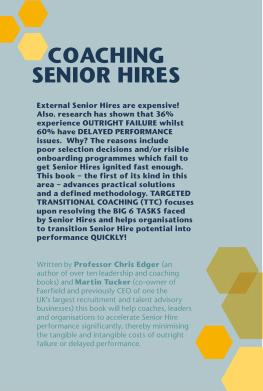ONBOARDING
Getting New Hires off to a
Flying Start
Christian Harpelund
Onboarding Group
With
Morten T. Hjberg
Kasper Ulf Nielsen

United Kingdom North America Japan
India Malaysia China
Emerald Publishing Limited
Illustrations drawn by Anders Frang. Anders Frang, 2016
First edition 2019
Copyright 2019 Emerald Publishing Limited
Reprints and permissions service
Contact:
No part of this book may be reproduced, stored in a retrieval system, transmitted in any form or by any means electronic, mechanical, photocopying, recording or otherwise without either the prior written permission of the publisher or a licence permitting restricted copying issued in the UK by The Copyright Licensing Agency and in the USA by The Copyright Clearance Center. Any opinions expressed in the chapters are those of the authors. Whilst Emerald makes every effort to ensure the quality and accuracy of its content, Emerald makes no representation implied or otherwise, as to the chapters suitability and application and disclaims any warranties, express or implied, to their use.
British Library Cataloguing in Publication Data
A catalogue record for this book is available from the British Library
ISBN: 978-1-78769-582-5 (Print)
ISBN: 978-1-78769-581-8 (Online)
ISBN: 978-1-78769-583-2 (Epub)

CONTENTS
LIST OF FIGURES
LIST OF TABLES
INTRODUCTION
Many of us have probably tried to convey the good news to the applicant who made it through the net. A small sentence of enormous importance: We have decided that we would like to offer you the position!
And it is a pleasure. Some employment bureaux and job centres even send champagne or flowers to the candidate to celebrate the occasion. The decision is the culmination of a lengthy process, and it not only delights the applicant, but also those of us who have made the final choice from the applicants for the position. We have often involved many colleagues along the way, maybe used a battery of tests and even used internal or external recruitment experts. But now weve achieved our objective. We can now enjoy having our new hire in place and begin to reap the fruits of the commitment they bring to the organisation.
Thats the way it is supposed to be, anyway. In the real world, however, it is almost naive to consider this to be the culmination of the process. Let us illustrate the point with some numbers:
Twenty-five percent of all new hires leave their positions before completing their first year of service. Forty-six percent of first-time job seekers who take up employment leave the job in the first 18 months.
Twenty-two percent of new hires who leave their jobs do so in the first 45 days of employment.
Four percent of new hires never return after their first day on the job.
These are figures that should alert every leader. In all these cases, the delight which accompanies the initial offer of employment is neither necessarily carried through into a meaningful career experience nor significant value to the organisation. The situation is not improved by the fact that although we have experienced this problem for many years, we in the
The code word, as the attentive reader might already have guessed, is onboarding. And that is exactly what this book is all about. It involves everything that happens once we have chosen our candidates and includes how we should begin to welcome them and help them to get going with the job. Onboarding is about controlling what happens when new hires are appointed. It is about controlling the way in which their perception of the company culture is established; ensuring that they build the right relationships with colleagues; and that from day one or even before that the efforts and results required of them are clear, so that they perform optimally. It is about leaving as little as possible to chance. Part of it is about the more basic needs: a chair to sit on, a phone to call from, a colleague to talk to, business cards, access cards and so on. But taking care of these aspects is nowhere near enough to reap the rewards that a thoroughly designed onboarding programme offers. And these rewards are considerable, let us assure you.
Research shows that proper onboarding increases new hire commitment, In other words, the returns for allocating resources to a sophisticated onboarding programme are enormous, and in many organisations are much higher than one could achieve by increasing investment in the recruitment.
One might ask: Wont onboarding always happen as people get into their job? Yes, and all organisations have an onboarding process whether or not they have ever given it any thought or effort. Doing nothing to welcome, introduce or support new hires is also an onboarding process. Its just not necessarily an onboarding process that does what it is supposed to do. And a bad onboarding process is not in any way a neutral thing. Very few organisations do nothing though and many have some sort of program to supply their new hires with information and the practical remedies they need to get started with their job. However, as we will argue throughout this book, these introduction activities rarely cover the needs of the onboarding process.
If you ask the Finance Department in your company whether a budget for an onboarding programme exists, you will probably get a negative answer. According to an American study of 500 companies, only 13 percent have set aside funds for onboarding. Compare that to the resources allocated to the recruitment it does not make sense. This could be compared to spending a year and several thousand euros planning your wedding and all that it entails with guest lists, invitations, clothing, venue, etc. and then, only when the guests arrive, starting to think about what food to serve them. Clearly not a recipe for success.
This book will give the reader the necessary understanding and the proper tools to draw up an onboarding programme that addresses the problem of colleagues leaving too soon or taking too long to become fully productive. The tools and insight the book offers can also be used to work strategically on a wide range of other issues which are important to the business: for example, boosting integration between silos, strengthening the process of change, enhancing performance and reducing the delay between start and full performance. Its a long list.
We, the authors, have worked intensively with recruitment, HR, learning and organisational development since the early 1990s. A decade ago we began to develop tools to support all the things that happen after the recruitment process. Throughout this decade, onboarding has increasingly become our focus of attention as a major Achilles-heel for many of our customers. We have collected our experiences in this book and coupled them with the research done by our own company, OnboardingGroup. We have built the experiences into a model, we believe that is straightforward enough to apply in any organisation, while still showing respect for the local complexities of onboarding. Our objective has not been to develop a new, complicated theory. Quite the opposite we have tried to create a structure for onboarding that draws from a selection of existing theories and practices.
We owe heartfelt thanks to numerous researchers, teachers and HR personnel, as well as the countless customers who have contributed to our onboarding project over the years. We also extend a warm thank you to all the organisations we have spoken to in connection with our onboarding work. Our many dialogues have given us a great deal of inspiration for positive and effective actions which we would like to share with others. We can also say, without intending to be insulting, that we were also given ideas about what not to do.



